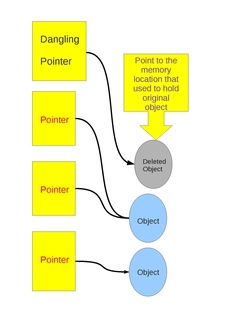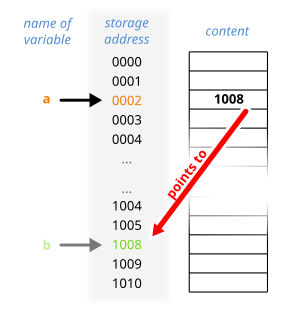In information security and programming, a buffer overflow, or buffer overrun, is an anomaly where a program, while writing data to a buffer, overruns the buffer's boundary and overwrites adjacent memory locations.

C is a general-purpose, imperative computer programming language, supporting structured programming, lexical variable scope and recursion, while a static type system prevents many unintended operations. By design, C provides constructs that map efficiently to typical machine instructions, and it has therefore found lasting use in applications that were previously coded in assembly language. Such applications include operating systems, as well as various application software for computers ranging from supercomputers to embedded systems.
The Cyclone programming language is intended to be a safe dialect of the C language. Cyclone is designed to avoid buffer overflows and other vulnerabilities that are possible in C programs, without losing the power and convenience of C as a tool for system programming.
This is a comparison of Java and C++, two prominent object-oriented programming languages.
In computer science, a reference is a value that enables a program to indirectly access a particular datum, such as a variable's value or a record, in the computer's memory or in some other storage device. The reference is said to refer to the datum, and accessing the datum is called dereferencing the reference.
The syntax of the C programming language, the rules governing writing of software in the language, is designed to allow for programs that are extremely terse, have a close relationship with the resulting object code, and yet provide relatively high-level data abstraction. C was the first widely successful high-level language for portable operating-system development.
In computer programming, undefined behavior (UB) is the result of executing computer code whose behavior is not prescribed by the language specification to which the code adheres, for the current state of the program. This happens when the translator of the source code makes certain assumptions, but these assumptions are not satisfied during execution.
Buffer overflow protection is any of various techniques used during software development to enhance the security of executable programs by detecting buffer overflows on stack-allocated variables, and preventing them from causing program misbehavior or from becoming serious security vulnerabilities. A stack buffer overflow occurs when a program writes to a memory address on the program's call stack outside of the intended data structure, which is usually a fixed-length buffer. Stack buffer overflow bugs are caused when a program writes more data to a buffer located on the stack than what is actually allocated for that buffer. This almost always results in corruption of adjacent data on the stack, which could lead to program crashes, incorrect operation, or security issues.
In computer science, cycle detection or cycle finding is the algorithmic problem of finding a cycle in a sequence of iterated function values.
In computing, aliasing describes a situation in which a data location in memory can be accessed through different symbolic names in the program. Thus, modifying the data through one name implicitly modifies the values associated with all aliased names, which may not be expected by the programmer. As a result, aliasing makes it particularly difficult to understand, analyze and optimize programs. Aliasing analysers intend to make and compute useful information for understanding aliasing in programs.
In the C++ programming language, a reference is a simple reference datatype that is less powerful but safer than the pointer type inherited from C. The name C++ reference may cause confusion, as in computer science a reference is a general concept datatype, with pointers and C++ references being specific reference datatype implementations. The definition of a reference in C++ is such that it does not need to exist. It can be implemented as a new name for an existing object.

Dangling pointers and wild pointers in computer programming are pointers that do not point to a valid object of the appropriate type. These are special cases of memory safety violations. More generally, dangling references and wild references are references that do not resolve to a valid destination, and include such phenomena as link rot on the internet.
Boundedness or bounded may refer to:
This is an overview of Fortran 95 language features. Included are the additional features of TR-15581:Enhanced Data Type Facilities, that have been universally implemented. Old features that have been superseded by new ones are not described — few of those historic features are used in modern programs although most have been retained in the language to maintain backward compatibility. Although the current standard is Fortran 2008, even many of those features first introduced into Fortran 2003 are still being implemented. The additional features of Fortran 2003 and Fortran 2008 are described by Metcalf, Reid and Cohen.
Memory safety is the state of being protected from various software bugs and security vulnerabilities when dealing with memory access, such as buffer overflows and dangling pointers. For example, Java is said to be memory-safe because its runtime error detection checks array bounds and pointer dereferences. In contrast, C and C++ allow arbitrary pointer arithmetic with pointers implemented as direct memory addresses with no provision for bounds checking, and thus are termed memory-unsafe.
Language support for array types may include certain built-in array data types, some syntactic constructions that the programmer may use to define such types and declare array variables, and special notation for indexing array elements. For example, in the Pascal programming language, the declaration type MyTable = array [1..4,1..2] of integer, defines a new array data type called MyTable. The declaration var A: MyTable then defines a variable A of that type, which is an aggregate of eight elements, each being an integer variable identified by two indices. In the Pascal program, those elements are denoted A[1,1], A[1,2], A[2,1],… A[4,2]. Special array types are often defined by the language's standard libraries.
The computer programming languages C and Object Pascal have similar times of origin, influences, and purposes. Both were used to design their own compilers early in their lifetimes.
Intel MPX is a set of extensions to the x86 instruction set architecture. With compiler, runtime library and operating system support, Intel MPX brings increased security to software by checking pointer references whose normal compile-time intentions are maliciously exploited at runtime due to buffer overflows.



